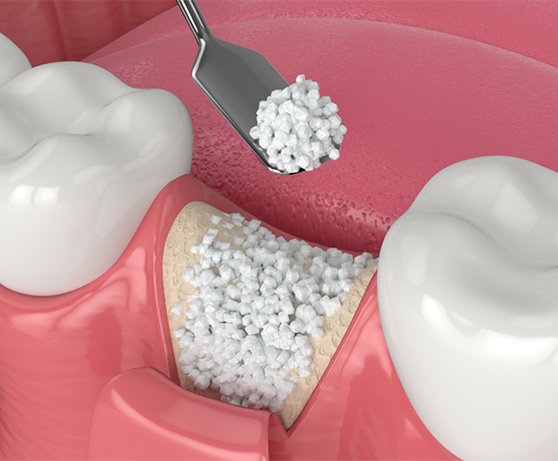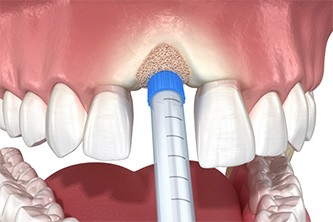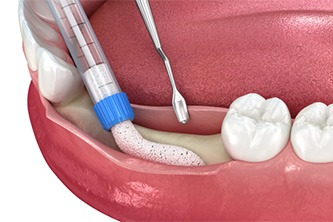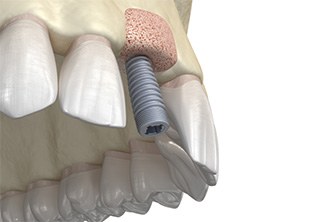Bone Grafting – Reston, VA
The First Step for a Lifetime of Smiles
Bone grafting is a procedure where transplanted bone tissue is used to repair and rebuild bones anywhere in your body. At NOVA Reston, we use it specifically to reverse damage to the jawbone. This can help prepare the area for implant surgery, but it can also be used to improve someone’s appearance and oral health at the same time. If you have concerns about tooth loss, bone loss, or have been told you couldn’t get dental implants in the past, we’re ready to offer a path forward. Reach out today to schedule a consultation and get started.
Why Choose Northern Virginia Oral, Maxillofacial & Implant Surgery for Bone Grafting?
- Team Led by Multiple Board-Certified Oral Surgeons
- Wide Variety of Bone Grafting Options
- Over 600 5-Star Reviews on Google
Benefits of Bone Grafting

We might recommend a bone grafting procedure if you’ve lost some or all of your teeth because of an accident, injury, or general decay. Left untreated, a jawbone without teeth atrophies as your body reabsorbs it. This process causes it to weaken and become brittle, making the placement of dental implants nearly impossible. Plus, this reduces the height of the face and causes the lips to roll inward, creating an aged and unhealthy appearance.
Bone grafting can restore your jaw to its near original length and width. It also makes it safe to rebuild your smile using dental implants in Reston, which can bring back your ability to eat, speak, and smile with ease while helping you look notably younger.
Types of Bone Grafting

At Northern Virginia Oral, Maxillofacial & Implant Surgery, we can use four different types of bone grafts:
Autogenous Bone Grafting

Autogenous bone grafts, or autografts, come from your own body. In most cases, we harvest autografts from your skull, leg, chin, or hip. They contain live bone and encourage natural bone growth. However, they require a second surgery to collect. As a result, the team typically recommends them for healthy, younger patients.
Allogenic Bone Grafting

Allogenic bone grafting uses bone material harvested from a cadaver, so unlike autografts, they don’t contain any live bone cells. Instead, the team uses the allogenic bone as a foundation over which healthy bone tissue can grow.
Xenogeneic Bone Grafting

Xenogeneic bone grafting uses tissue from another animal, such as a cow or pig. Before application, it undergoes extensive heating to prevent rejection or contamination. Similar to an allogenic bone graft, a xenogeneic bone graft serves as a foundation around which your natural tissue can grow.
Synthetic Bone Grafting

Thanks to modern technology and scientific advances, there is an array of synthetic materials used in bone grafting, including graft composites, bone morphogenic proteins, and demineralized bone matrices. Synthetic materials require only one surgery and lower your risk of complications and pain.
What Type of Bone Grafting Is Right For Me?

First, your oral surgeon will perform an oral exam, review your medical history, and take a series of X-rays. After gathering all this information, they can make recommendations based on your situation. While an autogenous bone graft tends to be accepted by the body better than the other options, many patients would rather not undergo two procedures. The other types are more straightforward but may require more healing time. All of these factors, including cost, will be discussed so you and your surgeon can make an informed decision together.
Bone Grafting FAQs
Does bone grafting hurt?
Rest assured, we’ll make sure you’re quite comfortable during your bone graft. Modern local anesthesia is very effective, and many patients find that it numbs their mouth enough that they don’t feel outright pain. You may feel some mild pressure as we work, but should feel no more uncomfortable than you would for other dental procedures.
That said, you’ll likely be sore after your bone graft. We recommend taking ibuprofen or Tylenol about one hour before your appointment and as the anesthetic starts to wear off. That way, the medicine will be able to “keep up” with post-treatment soreness.
How soon after bone grafting can I receive dental implants?
It will ultimately depend on how quickly your mouth heals. Everyone’s body is a little different when it comes to recovery! A good general estimate, though, is that you’ll have to wait at least four months to receive dental implants after your bone graft. We want to make sure the new bone material has merged properly with your jawbone so that your dental implants will have a firm foundation going forward.
Are there any risks associated with bone grafting?
Bone grafting is generally considered to be a safe treatment, make no mistake. However, like every procedure, there is a small chance that you could experience complications. Some of the risks include infection, bleeding, and failure of the graft material to properly integrate with your jawbone. Our team will take every precaution to help ensure the success of your bone graft, and will provide prompt treatment if you do encounter any complications.
We can also discuss the risks in more detail during your consultation, so please don’t hesitate to voice any questions or concerns. It’s important that you feel confident about your treatment plan!
What is recovery like after bone grafting?
For the first week or so after your bone graft, you might notice tenderness, bruising, or swelling. These effects are considered normal, and OTC pain relievers are often enough to alleviate discomfort. For bruising, we recommend gently applying a cold compress to the area.
You might also see tiny white particles coming from the treatment site that look like sand or salt. These are actually bone fragments, but don’t worry – it’s normal to lose small amounts of bone fragments during recovery. If you’re concerned or lose larger amounts of fragments, we’d be happy to take a closer look at the graft and make sure everything is progressing smoothly.
As your symptoms start to fade, remember that the graft itself will still be fusing with your jawbone. Please continue to follow our team’s aftercare instructions, even if you no longer experience soreness.
